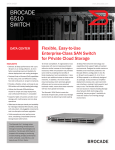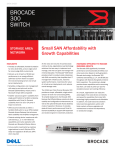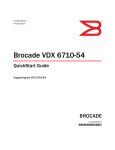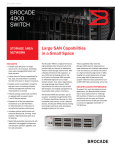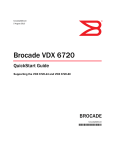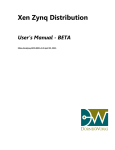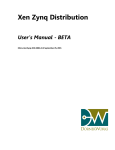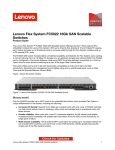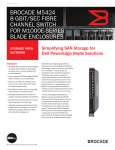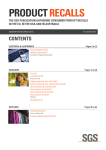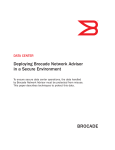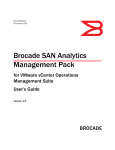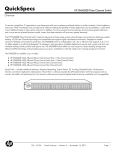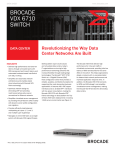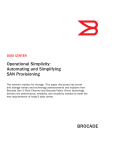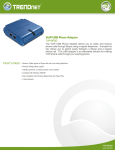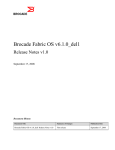Download DELL Brocade DCX 8510
Transcript
DATA SHEET www.brocade.com BROCADE DCX 8510 BACKBONE FAMILY DATA CENTER HIGHLIGHTS •Unleashes the full potential of private cloud storage with unmatched scalability, performance, and reliability •Leverages Brocade UltraScale chassis connectivity for simpler, flatter, lowlatency fabrics that reduce network complexity, management, and costs •Optimizes data center connectivity over distance with integrated high-performance metro and global connectivity •Simplifies and centralizes end-to-end SAN management with comprehensive diagnostics, monitoring, and automation through Brocade Fabric Vision technology •Maximizes performance for I/O- and bandwidth-intensive applications •Protects investments in existing SAN fabrics and automation tools while reducing operational costs and minimizing business disruption Gen 5 Fibre Channel is the purposebuilt, data center-proven network infrastructure for storage, delivering unmatched reliability, simplicity, and 16 Gbps performance. The Brocade DCX 8510 with Gen 5 Fibre Channel unleashes the full potential of high-density server virtualization, cloud architectures, and nextgeneration storage. A Foundation for Server Virtualization, Flash Storage, and Cloud Architectures Brocade® DCX® 8510 Backbones are the industry’s most reliable, scalable, and high-performance Gen 5 Fibre Channel switching infrastructure for mission-critical storage. They are designed to increase business agility while providing non-stop access to information and reducing infrastructure and administrative costs. Networks need to evolve in order to support the growing demands of highly virtualized environments, new flash-based storage, and private cloud architectures. Fibre Channel, the de facto standard for storage networking, is evolving with the data center. Brocade DCX 8510 Backbones with Gen 5 Fibre Channel deliver a new level of scalability and advanced capabilities to this robust, reliable, and high-performance technology. This enables organizations to continue leveraging their existing IT investments as they grow their businesses. In addition, they can consolidate their Storage Area Network (SAN) infrastructures to simplify management and reduce operating costs. MAXIMUM FLEXIBILITY AND RELIABILITY Brocade DCX 8510 Backbones are available in two modular form factors. Built for large enterprise networks, the 14U Brocade DCX 8510-8 has eight vertical blade slots to provide up to 384 16 Gbps Fibre Channel ports. Built for midsize networks, the 8U Brocade DCX 8510-4 has four horizontal blade slots to provide up to 192 16 Gbps Fibre Channel ports. The Brocade DCX 8510 family supports 2, 4, 8, 10, and 16 Gbps Fibre Channel, FICON®, and 1/10 Gbps Fibre Channel over IP (FCIP). To help minimize downtime costs, Brocade DCX 8510 Backbones build upon years of innovation and leverage the core technology of Brocade systems performing at greater than 99.999 percent uptime in the world’s most demanding data centers. SIMPLIFIED SCALE-OUT NETWORK DESIGN Networks are evolving in order to adapt to rapid growth and change in the server and storage infrastructure. Brocade UltraScale chassis connectivity leverages optical Inter-Chassis Links (ICLs) of up to 100 meters to connect up to 10 Brocade DCX 8510 Backbones, enabling flatter, faster, and simpler fabrics that increase consolidation while reducing network complexity and costs. UltraScale ICLs enable scalable core-edge and active-active mesh chassis topologies. These high-density chassis topologies reduce inter-switch cabling by 75 percent and free up to 33 percent of ports for server and storage. This maximizes overall port density in the lowest amount of rack space. SIMPLIFIED MANAGEMENT AND ROBUST NETWORK ANALYTICS Brocade Fabric Vision technology, an extension of Brocade Gen 5 Fibre Channel, introduces a breakthrough hardware and software solution that maximizes uptime, simplifies SAN management, and provides unprecedented visibility and insight across the storage network. Offering innovative diagnostic, monitoring, and management capabilities, the Brocade DCX 8510 with Fabric Vision technology helps administrators avoid problems, maximize application performance, and reduce operational costs. Brocade Fabric Vision technology includes: •Flow Vision: Enables administrators to identify, monitor, and analyze specific application and data flows in order to maximize performance, avoid congestion, and optimize resources. Flow Vision includes: –– Flow Monitor: Provides comprehensive visibility into flows in the fabric, including the ability to automatically learn (discover) flows and nondisruptively monitor flow performance. Users can monitor all flows from a specific host to multiple targets/LUNs or from multiple hosts to a specific target/LUN; monitor all flows across a specific ISL; or perform LUN-level monitoring of specific frame types to identify resource contention or congestion that is impacting application performance. –– Flow Mirror: Provides the ability to non-disruptively create copies of specific application and data flows or frame types that can be captured for deeper analysis. –– Flow Generator: Provides a built-in test traffic generator for pre-testing and validating the SAN infrastructure, including verification of routes and integrity of optics, cables, ports, and ISLs, for robustness before deploying applications. •Monitoring and Alerting Policy Suite (MAPS): Simplifies fabric-wide threshold configuration and monitoring. By leveraging pre-built rule/policy-based templates, applying thresholds and alerts to ports and switches is a simple two-step UNMATCHED MAINFRAME TECHNOLOGY INNOVATION AND LEADERSHIP The Brocade DCX 8510 matches the highest-performing and most reliable FICON infrastructure with the industry’s fastest and most scalable System z mainframes. Brocade builds on more than 25 years of mainframe leadership that includes designing the FICON standard and authoring many FICON patents. process. Organizations can configure the entire fabric (or multiple fabrics) at one time using common rules and policies, or customize policies for specific ports or switch elements—all through a single dialog. The integrated dashboard displays an overall switch health report, along with details on out-of-policy conditions, to help administrators quickly pinpoint potential issues and easily identify trends and other behaviors occurring on a switch or fabric. •Brocade ClearLink Diagnostics: Ensures optical and signal integrity for Gen 5 Fibre Channel optics and cables, simplifying deployment and support of high-performance fabrics. It leverages ClearLink Diagnostic Port (D_Port) capabilities of Gen 5 Fibre Channel platforms. •Bottleneck Detection: Identifies and alerts administrators to device or ISL congestion as well as abnormal levels of latency in the fabric. It works in conjunction with Brocade Network Advisor to automatically monitor and detect network congestion and latency in the fabric, providing visualization of bottlenecks in a connectivity map and product tree, and identifying exactly which devices and hosts are impacted by a bottle-necked port. •Integration into Brocade Network Advisor: Provides customizable health and performance dashboard views to pinpoint problems faster, simplify SAN configuration and management, and reduce operational costs. •Critical diagnostic and monitoring capabilities: Help ensure early problem detection and recovery. •Non-intrusive and non-disruptive monitoring on every port: Provides a comprehensive end-to-end view of the entire fabric using capabilities integrated into hardware, allowing sophisticated monitoring without imposing an additional burden on switches with frequent polling activity. •Forward Error Correction (FEC): Enables recovery from bit errors in ISLs, enhancing transmission reliability and performance. •Credit Loss Recovery: Helps overcome performance degradation and congestion due to buffer credit loss. •Real-time bandwidth consumption by hosts/applications on ISLs: Helps easily identify hot spots and potential network congestion. OPTIMIZED DATA CENTER CONNECTIVITY OVER DISTANCE Connecting distributed data centers enables data mobility for advanced data protection solutions. Brocade DCX 8510 Backbones include integrated metro and global SAN extension that provides application agility and flexible business continuity and disaster recovery solutions. The Brocade DCX 8510 family enables high-speed replication and backup solutions over metro or WAN links with native Fibre Channel (10/16 Gbps) and optional FCIP (1/10 GbE) extension support. The integrated metro connectivity includes in-flight compression and encryption to optimize bandwidth and minimize the risk of unauthorized access. INDUSTRY-LEADING PERFORMANCE Emerging and evolving critical workloads and higher density virtualization are continuing to push the limits of SAN infrastructure. The Brocade DCX 8510 features industry-leading Gen 5 Fibre Channel that provides 16 Gbps line-speed performance and 8.2 Tbps chassis bandwidth to address next-generation I/O- and bandwidth-intensive applications. Brocade DCX 8510 Backbones provide unmatched chassis, slot-to-slot, and port performance and bandwidth. In addition, local switching capabilities ensure that data traffic within the same port group does not consume slot bandwidth, maximizing the number of line-rate ports. Performance capabilities include: •Brocade DCX 8510-8: –– Up to 384 ports (equivalent to 512 with UltraScale ICLs) at 16 Gbps –– 8.2 Tbps chassis bandwidth •6.1 Tbps Fibre Channel/FICON ports •2.1 Tbps UltraScale ICL bandwidth –– 512 Gbps bandwidth per slot •Brocade DCX 8510-4: –– Up to 192 ports (equivalent to 256 with UltraScale ICLs) at 16 Gbps –– 4.1 Tbps chassis bandwidth •3.1 Tbps Fibre Channel/FICON ports •1 Tbps UltraScale ICL bandwidth –– 512 Gbps bandwidth per slot BROCADE GLOBAL SERVICES Brocade Global Services has the expertise to help organizations build scalable, efficient cloud infrastructures. Leveraging 15 years of expertise in storage, networking, and virtualization, Brocade Global Services delivers world-class professional services, technical support, and education services, enabling organizations to maximize their Brocade investments, accelerate new technology deployments, and optimize the performance of networking infrastructures. MAXIMIZING INVESTMENTS To help optimize technology investments, Brocade and its partners offer complete solutions that include professional services, technical support, and education. For more information, contact a Brocade sales partner or visit www.brocade.com. BROCADE DCX 8510 BACKBONE SPECIFICATIONS Systems Architecture Chassis Single chassis: Up to 384 (Brocade DCX 8510-8) or 192 (Brocade DCX 8510-4) 16 Gbps (E, F, D, M, and EX) Fibre Channel ports using 48-port 16 Gbps Fibre Channel blades. Up to 512 (Brocade DCX 8510-8) or 256 (Brocade DCX 8510-4) 8 Gbps (E, F, D, M, and EX) Fibre Channel ports using 64-port 8 Gbps Fibre Channel blades. Multi-chassis with UltraScale ICL ports: Up to 3840 16 Gbps Fibre Channel ports (using 16 Gbps 48-port blades); up to 5120 8 Gbps Fibre Channel ports (using 8 Gbps 64-port blades); UtraScale ICL ports (32 or 16 per chassis, optical QSFP) connect up to nine chassis in a full mesh topology or up to 10 chassis in a core-edge topology. Each Brocade DCX 8510 chassis that connects to four or more Brocade DCX 8510 chassis via UltraScale ICLs requires an Enterprise ICL license. Control processor Redundant (active/standby) control processor modules Scalability Full fabric architecture of 239 switches Certified maximum 6000 active nodes; 56 switches, 19 hops in Brocade Fabric OS® fabrics; 31 switches, larger fabrics certified as required Special-purpose blades Brocade FS8-18 Encryption Blade provides plug-in encryption of data on disk or tape, supporting industry-standard AES-256 and DataFort-compatible encryption mode (16 8 Gbps Fibre Channel ports; up to four blades; requires Brocade Network Advisor). Brocade FX8-24 Extension Blade provides SAN extension over IP networks (12 8 Gbps Fibre Channel ports, 10 1 GbE ports with license option for up to two 10 GbE ports per blade; up to four blades). Performance ISL trunking Fibre Channel: 2.125 Gbps line speed, full duplex; 4.25 Gbps line speed, full duplex; 8.5 Gbps line speed, full duplex; 10.53 Gbps line speed, full duplex; 14.025 Gbps line speed, full duplex; auto-sensing of 2, 4, 8, and 16 Gbps port speeds; 10 Gbps and optionally programmable to fixed port speed Frame-based trunking with up to eight 16 Gbps ports per ISL trunk; up to 128 Gbps per ISL trunk Exchange-based load balancing across ISLs with DPS included in Brocade Fabric OS Chassis bandwidth Brocade DCX 8510-8: 8.2 Tbps per chassis (384 ports × 16 Gbps data rate + 2.048 Tbps UltraScale ICL bandwidth) Brocade DCX 8510-4: 4.1 Tbps per chassis (192 ports × 16 Gbps data rate + 1.024 Tbps UltraScale ICL bandwidth) Slot bandwidth 512 Gbps (data rate) Local switching bandwidth 512 Gbps for Brocade FC16-32: 32 ports × 16 Gbps (data rate) 768 Gbps for Brocade FC16-48: 48 ports × 16 Gbps (data rate) 256 Gbps for Brocade FC8-32E: 32 ports × 8 Gbps (data rate) 384 Gbps for Brocade FC8-48E: 48 ports × 8 Gbps (data rate) 512 Gbps for Brocade FC8-64: 64 ports × 8 Gbps (data rate) UltraScale ICL bandwidth Brocade DCX 8510-8: 2.048 Tbps; 32 UltraScale ICL ports provide the equivalent of 128 16 Gbps ports. Each UltraScale ICL port provides 64 Gbps bandwidth over a QSFP (4×16 Gbps) link. Brocade DCX 8510-4: 1.024 Tbps; 16 UltraScale ICLs provide the equivalent of 64 16 Gbps ports. Each UltraScale ICL port provides 64 Gbps bandwidth over a QSFP (4×16 Gbps) link. Both models: Frame-based trunking is enabled between four UltraScale ICLs. DPS distributes exchanges across all frame trunks. Switch latency Locally switched port latency is 700 ns; blade-to-blade latency is 2.1 µsec; encryption/compression is 5.5 µsec per node; Forward Error Correction (FEC) adds 400 ns between E_Ports (enabled by default). Maximum frame size 2112-byte payload Frame buffers 8192 per 16-port group on 32-port blades and up to 8192 per 24-port group on 48-port blades, dynamically allocated Classes of service Class 2, Class 3, Class F (inter-switch frames) Fibre Channel port types D_Port (ClearLink Diagnostic Port), E_Port, EX_Port, F_Port, M_Port (Mirror Port); optional port type control Data traffic types Fabric switches supporting unicast BROCADE DCX 8510 BACKBONE SPECIFICATIONS (CONTINUED) Media types 16 Gbps: Brocade FC16-32 and -48 require Brocade hot-pluggable SFP+, LC connector; 16 Gbps SWL, LWL, ELWL 10 Gbps: Brocade FC16-32 and -48 require Brocade hot-pluggable SFP+, LC connector; 10 Gbps SWL, LWL 8 Gbps: Brocade FC16-32 and -48; Brocade FC8-32E and -48E; Brocade FX8-24; and Brocade FS8-18 blades require Brocade hot-pluggable SFP+, LC connector; 8 Gbps SWL, LWL, ELWL High Availability Architecture Passive backplane; redundant active/passive control processor; redundant active/active core switching blades; redundant WWN cards Chassis power Two 2000 W AC power supply modules (100 to 240 V auto-sensing), 2N redundancy; Brocade DCX 8510-8 supports two additional power modules Cooling Brocade DCX 8510-8: Three blower assembly modules (two required for operation) 8 Gbps: Brocade FC8-64 blades require Brocade hotpluggable mSFP, mSFP LC connector; 8 Gbps SWL only UltraScale ICL QSFP: Brocade CR16-8 and CR16-4 require Brocade hot-pluggable QSFP, MTP connector; 4×16 Gbps SWL (50 m OM3, 100 m OM4) Brocade DCX 8510-4: Two blower assembly modules (one required for operation) Solution availability Fibre Channel distance subject to fiber-optic cable and port speed USB 1 USB port per control processor for firmware download, support save, and configuration upload/download Fabric services Brocade Advanced Performance Monitoring (APM) (including Top Talkers for E_Ports, F_Ports, and Fabric mode); Brocade Adaptive Networking (Ingress Rate Limiting, Traffic Isolation, QoS); Bottleneck Detection; Brocade Advanced Zoning (default zoning, port/WWN zoning, broadcast zoning); Dynamic Fabric Provisioning (DFP); Dynamic Path Selection (DPS); Brocade Extended Fabrics; Enhanced BB credit recovery; Brocade Fabric Watch; FDMI; Flow Vision; Frame Redirection; Frame-based Trunking; FSPF; Integrated Routing; IPoFC; Brocade ISL Trunking; Management Server; Monitoring and Alerting Policy Suite (MAPS); NPIV; NTP v3; Port Fencing; Registered State Change Notification (RSCN); Reliable Commit Service (RCS); Brocade Server Application Optimization (SAO); Simple Name Server (SNS); Virtual Fabrics (Logical Switch, Logical Fabric) Extension Supports DWDM, CWDM, and FC-SONET devices; Fibre Channel, in-flight compression (Brocade LZO) and encryption (AES-GCM-256) BB credit recovery; FCIP, Adaptive Rate Limiting (ARL), data compression, Fast Write, read/write Tape Pipelining, QoS FICON FICON cascading (Brocade Fabric OS: Brocade DCX 8510-8, DCX 8510-4); support for lossless DLS; FICON CUP; Advanced Accelerator for FICON (FICON Global Mirror and XRC emulation and read/write Tape Pipelining). The Brocade FC8-64 blade does not support FICON. Designed to provide 99.999 percent uptime capabilities; hot-pluggable redundant power supplies, fans, WWN cards, processors, core switching, port blades, and optics; online diagnostics; non-disruptive firmware download and activation Management Management HTTP, SNMP v1/v3 (FE MIB, FC Management MIB), SSH; Auditing, Syslog; Brocade Advanced Web Tools, Brocade Network Advisor SAN Enterprise or Brocade Network Advisor SAN Professional Plus; Command Line Interface (CLI); SMI-S compliant; Administrative Domains; trial licenses for add-on capabilities Security AES-GCM-256 encryption on ISLs; DH-CHAP (between switches and end devices), FCAP switch authentication; FIPS 140-2 L2-compliant, HTTPS, IPsec, IP filtering, LDAP with IPv6, OpenLDAP, Port Binding, RADIUS, User-defined Role-Based Access Control (RBAC), Secure Copy (SCP), Secure RPC, SFTP, SSH v2, SSL, Switch Binding, TACACS+, Trusted Switch Management access 10/100/1000 Ethernet (RJ-45) per control processor, in-band over Fibre Channel; serial port (RJ-45) and one USB per control processor module; call-home integration enabled through Brocade Network Advisor Diagnostics Built-in flow generator, ClearLink optics and cable diagnostics, including electrical/optical loopback, link traffic/latency/distance; POST and embedded online/ offline diagnostics, including environmental monitoring, FCping and Pathinfo (FC traceroute), flow mirroring, frame viewer, non-disruptive daemon restart, port mirroring, optics health monitoring, power monitoring (16 Gbps blades-only), RAStrace logging, and Rolling Reboot Detection (RRD) BROCADE DCX 8510 BACKBONE SPECIFICATIONS (CONTINUED) Mechanical Specifications Environment Enclosure Rear panel-to-door airflow; Brocade DCX 8510-4 ships with 1U exhaust shelf Temperature Operating: 0°C to 40°C (32°F to 104°F) Non-operating: –25°C to 70°C (–13°F to 158°F) Mounting Rack-mountable in a standard 19-inch EIA cabinet Humidity Size Brocade DCX 8510-8 Width: 43.74 cm (17.22 in.) Height: 61.24 cm (24.11 in., 14U) Depth (without door): 61.19 cm (24.09 in.) Depth (with door): 73.20 cm (28.82 in.) Brocade DCX 8510-4 Width: 43.74 cm (17.22 in.) Height: 35.00 cm (13.78 in., 8U) plus 4.37 cm exhaust shelf (1.72 in, 1U) Depth without door: 61.19 cm (24.09 in.) Depth with door: 73.20 cm (28.82 in.) Operating humidity: 5% to 93% RH non-condensing at 40°C (104°F) with a maximum gradient of 10% per hour Non-operating humidity: 10% to 93% RH noncondensing at 70°C (158°F) Altitude Up to 3000 meters (9842 feet) Shock Operating: 20 g, 6 ms, half sine Non-operating: 33 g, 11 ms, half sine Vibration Operating: 0.5 g p-p, 5 to 500 Hz Non-operating: 2.0 g p-p, 5 to 500 Hz Heat dissipation Brocade DCX 8510-8 Min: 32-port configuration (no QSFP), 986 W, 3365 BTU/hr Max: 384-port configuration (fully loaded with QSFPs), 2429 W, 8283 BTU/hr Brocade DCX 8510-4 Min: 32-port configuration, 713 W, 2433 BTU/hr Max: 192-port configuration (fully loaded with QSFPs), 1347 W, 4592 BTU/hr CO2 emissions Brocade DCX 8510-8 7.8 metric tonnes per year (with 384 ports at 0.42 kg/kWh) 0.95 kg per Gbps per year Brocade DCX 8510-4 4.3 metric tonnes per year (with 256 ports at 0.42 kg/kWh) 1.04 kg per Gbps per year System weight Brocade DCX 8510-8 103.50 kg (228.20 lb) for 384-port configuration fully populated 39.55 kg (82.20 lb) for chassis Brocade DCX 8510-4 68.04 kg (150.00 lb) for 192-port configuration fully populated 25.76 kg (56.80 lb) for chassis Power Supported power range Voltage Range: 85 to 264 VAC Auto-volt Nominal: 100 to 240 VAC Power 85 to 132 VAC: 1000 W 180 to 264 VAC: 2000 W In-rush current 60 Amps maximum, peak Frequency 47 to 63 Hz (Nominal: 50 to 60 Hz) For information about supported SAN standards, visit www.brocade.com/sanstandards. For information about switch and device interoperability, visit www.brocade.com/interoperability. For information about hardware regulatory compliance, visit www.brocade.com/regulatorycompliance. DATA SHEET Corporate Headquarters San Jose, CA USA T: +1-408-333-8000 [email protected] www.brocade.com European Headquarters Geneva, Switzerland T: +41-22-799-56-40 [email protected] Asia Pacific Headquarters Singapore T: +65-6538-4700 [email protected] © 2014 Brocade Communications Systems, Inc. All Rights Reserved. 05/14 GA-DS-1564-10 ADX, AnyIO, Brocade, Brocade Assurance, the B-wing symbol, DCX, Fabric OS, HyperEdge, ICX, MLX, MyBrocade, OpenScript, VCS, VDX, and Vyatta are registered trademarks, and The Effortless Network and The On-Demand Data Center are trademarks of Brocade Communications Systems, Inc., in the United States and/or in other countries. Other brands, products, or service names mentioned may be trademarks of others. Notice: This document is for informational purposes only and does not set forth any warranty, expressed or implied, concerning any equipment, equipment feature, or service offered or to be offered by Brocade. Brocade reserves the right to make changes to this document at any time, without notice, and assumes no responsibility for its use. This informational document describes features that may not be currently available. Contact a Brocade sales office for information on feature and product availability. Export of technical data contained in this document may require an export license from the United States government.








